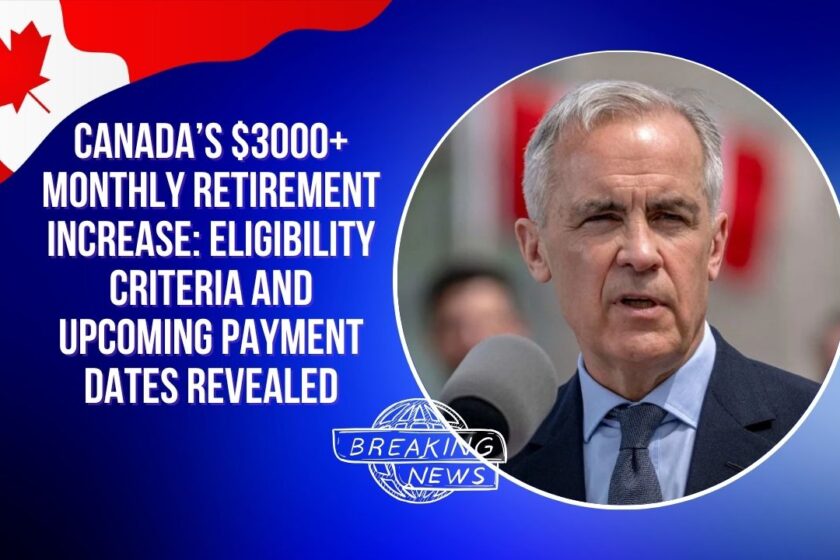As living expenses continue to climb across Canada, many retirees are finding it harder to keep up. In response, the Canadian government has improved key retirement programs, allowing eligible seniors to secure over $3,000 per month by combining three major benefits: the Canada Pension Plan (CPP), Old Age Security (OAS), and the Guaranteed Income Supplement (GIS).
These three programs form a comprehensive safety net, particularly vital for individuals with minimal personal savings or those without employer pensions. Knowing how these benefits interact is essential to optimize your monthly retirement income.
How CPP, OAS, and GIS Work Together
Canada’s public retirement income system is built on multiple support layers, each with its own rules. Here’s a breakdown of how each component plays a role in your financial well-being.
Canada Pension Plan (CPP): Based on Contributions
The CPP is a contributory plan, meaning the amount you receive is directly tied to:
- The number of years you contributed
- The total amount you paid into the plan
- The age you start collecting your benefits
You can choose to start receiving CPP as early as age 60 or delay it until age 70 for a higher monthly amount. CPP payments are taxable and count as part of your annual income, which can impact your GIS eligibility.
Old Age Security (OAS): Residency-Based Support
The OAS is available to Canadian residents aged 65 and above who meet certain residency criteria.
- You need at least 10 years of residence in Canada after age 18 to qualify
- To receive the full benefit, you must have lived in Canada for 40 years or more post-18
Like CPP, OAS is taxable and influences your eligibility for GIS.
Guaranteed Income Supplement (GIS): Support for Low-Income Seniors
The GIS is a non-taxable supplement designed for seniors who have low annual incomes and are already receiving OAS.
- GIS is income-tested: the less you earn, the more you may receive
- No contributions are needed to qualify
- Your eligibility depends on your net annual income, not including OAS
GIS serves as a lifeline for seniors struggling with rent, groceries, or utility bills.
July 2025: Maximum Monthly Retirement Benefits Overview
Here’s a snapshot of the maximum possible monthly benefits as of July 2025 for eligible Canadian seniors:
| Program | Monthly Maximum (CAD) | Eligibility Criteria |
|---|---|---|
| CPP | $1,364.60 | Full contribution history, claiming at age 65 |
| OAS | $748.00 | Age 65+, 40+ years residency in Canada |
| GIS (Single) | $1,065.47 | Low-income seniors receiving OAS |
| Total | $3,178.07 | Full eligibility across all programs |
Note: These figures represent the maximum amounts. Actual benefits vary depending on your income, contribution history, and marital status.
How to Increase Your Monthly Retirement Income
Not every retiree will qualify for the full $3,178.07, but there are ways to maximize what you receive each month.
Key Strategies for Boosting Your Benefits
- Delay CPP or OAS until age 70 to increase monthly payments
- Minimize your taxable income to maintain eligibility for GIS
- File your taxes every year to ensure automatic reassessment of benefits
- Coordinate with your spouse to spread income more evenly and retain GIS eligibility
Being strategic with your income structure and benefit timing can significantly impact your overall income.
Stay Informed About Policy Updates
Retirement benefits and eligibility rules may change annually. Staying informed through Service Canada and the CRA helps ensure you don’t miss out on:
- New payment rates
- Eligibility adjustments
- Important application deadlines
Why These Government Benefits Are More Important Than Ever
In today’s economic environment, with soaring inflation, housing prices, and healthcare costs, these benefits are no longer optional luxuries—they are essential tools for financial survival.
By offering a monthly income exceeding $3,000, these federal programs help:
- Combat poverty among retirees
- Promote financial independence
- Support a dignified lifestyle in retirement
Conclusion
For Canadian seniors, understanding and leveraging the CPP, OAS, and GIS programs can provide a significant financial boost in retirement. While not everyone will qualify for the maximum amount, proper planning, timely applications, and staying updated can lead to more income and greater peace of mind. Take the time now to review your eligibility, speak to a financial advisor, and strategize for a more secure future.
FAQs
What is the maximum amount a retiree can receive from CPP, OAS, and GIS in 2025?
In July 2025, the combined maximum monthly benefit is $3,178.07 if you qualify fully for CPP, OAS, and GIS.
Can I receive all three benefits (CPP, OAS, and GIS) at the same time?
Yes. If you meet the eligibility criteria for each program, you can receive all three payments simultaneously.
Is GIS automatically added to my OAS?
No. While OAS enrollment may be automatic, you must apply separately for GIS and renew it annually based on your income.
Will working part-time in retirement affect my GIS payments?
Yes. Any additional income from part-time work or investments is considered in your net annual income and may reduce or disqualify you from receiving GIS.
Are CPP and OAS taxable?
Yes. Both CPP and OAS are considered taxable income, while GIS is not taxed but is income-tested, meaning your taxable income can reduce GIS eligibility.

